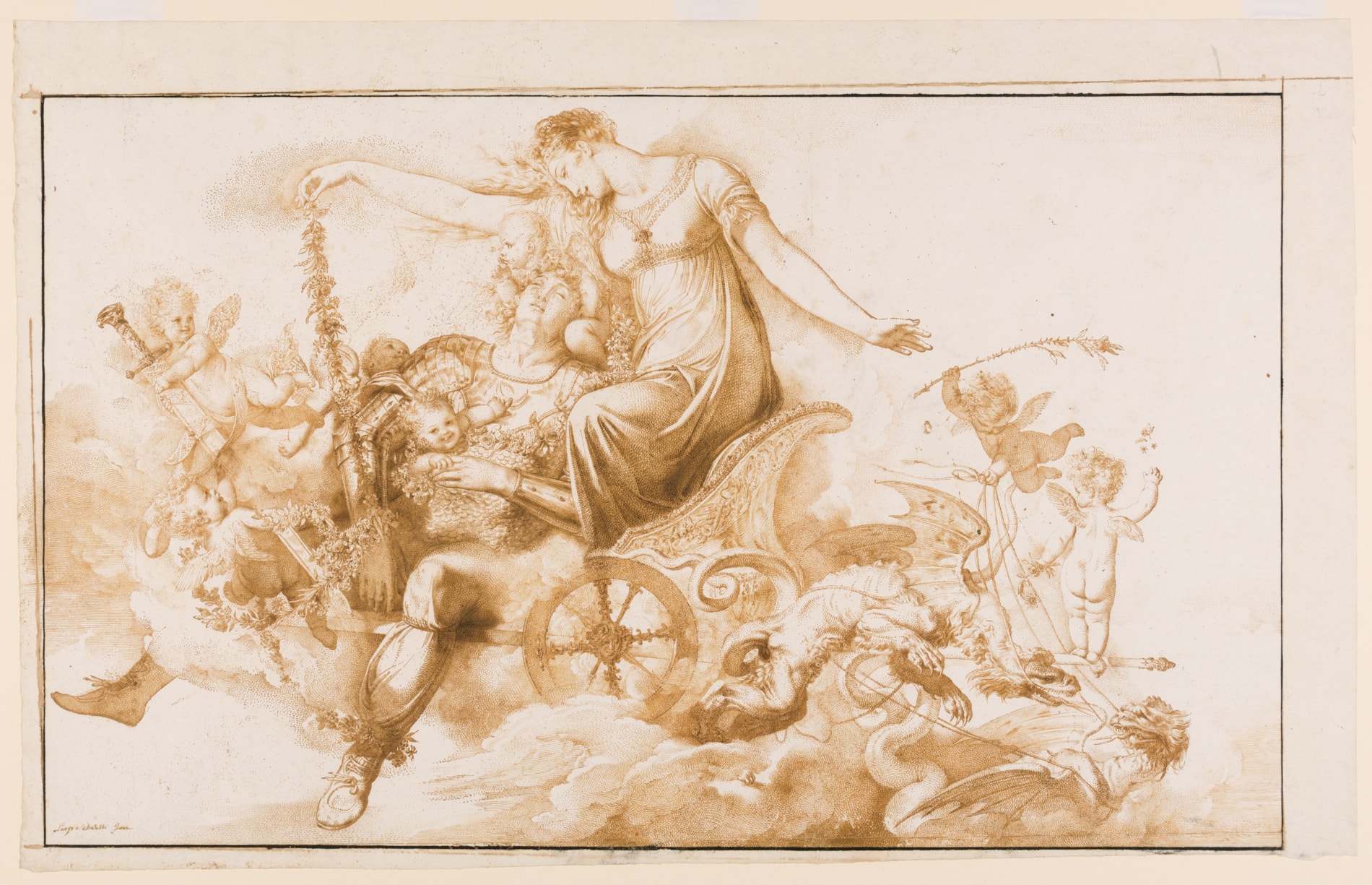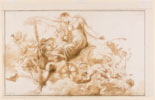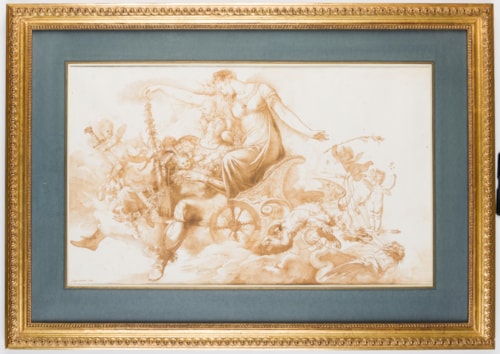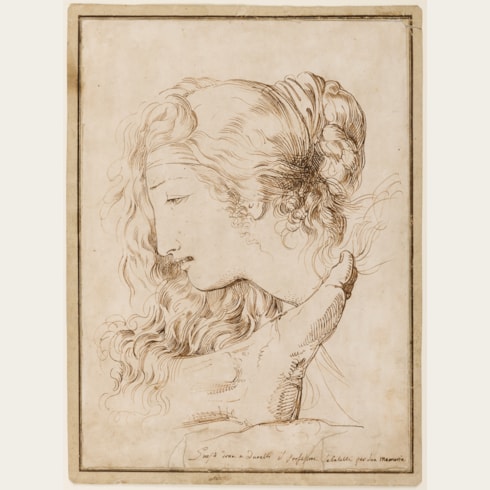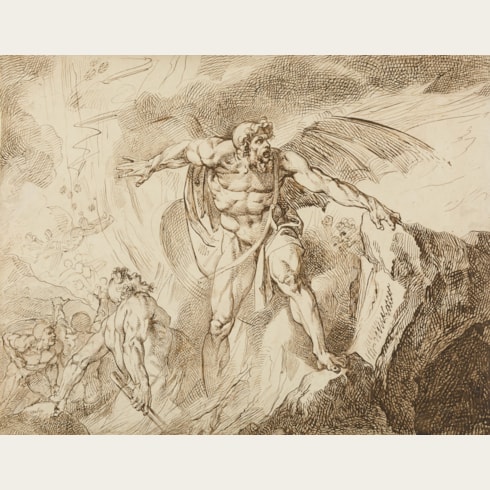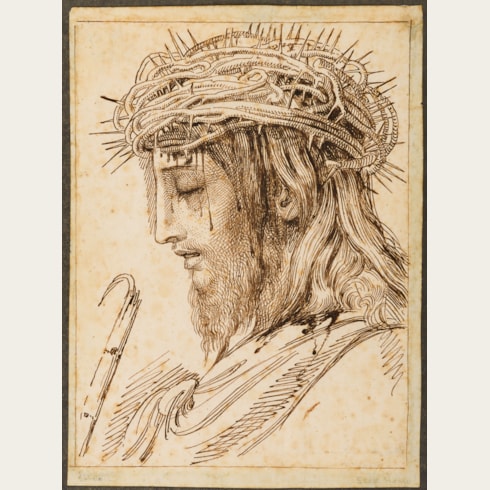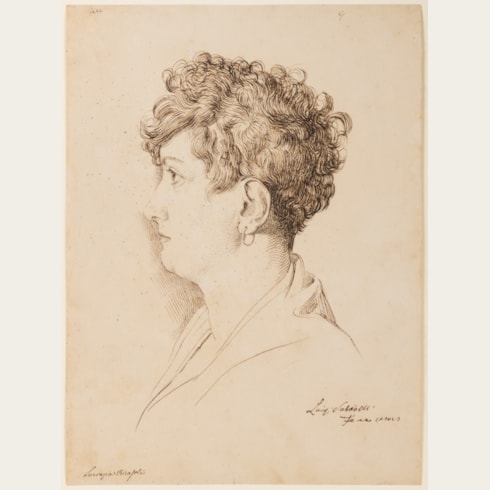Luigi SABATELLI
(Florence 1772 - Milan 1850)
Rinaldo and Armida on a Chariot Drawn by Dragons
Signed Luigi Sabatelli fece at the lower left.
424 x 699 mm. (16 1/4 x 27 1/2 in.) [image]
480 x 754 mm. (18 7/8 x 29 3/4 in.) [sheet]
ACQUIRED BY THE YALE UNIVERSITY ART GALLERY, NEW HAVEN, CT.
A superb example of the vigour of Luigi Sabatelli’s pen draughtsmanship, and what has been aptly described as the artist’s ‘virtuoso calligraphy’, this very large drawing may be dated to the artist’s years in Rome, between 1789 and 1794, and in particular towards the end of that period. The subject is taken from Canto XIV of the 16th century epic poem Gerusalemme Liberata by Torquato Tasso, and depicts the abduction of the Christian knight Rinaldo by the sorceress Armida. Rinaldo, having fallen asleep under Armida’s magic spell, and bound with a chain of roses, lilies and woodbines, is taken in her chariot to her palace on the Island of the Fortunate. It is interesting to note that Sabatelli has here shown the chariot drawn by dragons, in keeping with Tasso’s original text, instead of the horses found in almost all depictions of this theme in Italian art. Indeed, the striking and original conception of the creatures is typical of the inventiveness and imagination common to much of Sabatelli’s work. Despite the popularity of Tasso’s epic poem among artists, the theme of the abduction of Rinaldo by Armida in her chariot is rare in Italian art, and Sabatelli may have taken inspiration for the composition of this drawing from Guercino’s ceiling fresco of the same subject, painted in c.1621, in the Palazzo Costaguti in Rome.
At least two other large and highly finished pen and ink drawings by Luigi Sabatelli take their subjects from Tasso’s Gerusalemme Liberata. A drawing of Armida Abandoned is in a private collection, while a more obscure subject from the poem, Ismen Populating the Forest of Saron with Demons, is depicted in a drawing now in the National Gallery of Canada in Ottawa. (A further pen and ink drawing from Tasso, The Infernal Council from Canto IV, is mentioned in Sabatelli’s autobiography.) As David Franklin has noted, ‘The purpose of the Tasso drawings has not yet been established, but since Sabatelli was an accomplished printmaker and the studies are so finished and complete, it is possible they were intended as designs for a new (but unrealized) large-format edition of the text. Perhaps more likely, they were created as works in their own right, maybe even meant playfully to imitate the permanence of engravings, to judge by the tight, even hatching. The complete lack of wash and the bold, virtuoso handling would strongly support the interpretation that these drawings were always intended as demonstration sketches of a type the artist sometimes sold to private collectors.’
This impressive drawing of Rinaldo and Armida on a Chariot drawn by Dragons has, indeed, much in common with a series of large and highly finished pen drawings commissioned from the artist by Tommaso Puccini. An erudite connoisseur, Puccini seems to have had a particular penchant for dramatic and visionary scenes from literature, and encouraged Sabatelli to treat such themes in his work. Several very large pen drawings made by Sabatelli for Puccini are today in the collection of the Uffizi, including Philopoemen Kills Machanidas, signed and dated 1793, and two versions of Athenodorus and the Ghost. Among other comparable drawings of similar size and technique by Sabatelli are The Madness of Orlando in the Philadelphia Museum of Art, which, like the present sheet, was once in the Capponi collection in Florence, and several works in private collections, including two large pen and ink drawings of Dido Abandoned and Dante Conversing with Farinata degli Uberti.
The present sheet was one of fourteen large pen and ink drawings by Luigi Sabatelli recorded in the collection of the 19th century Florentine historian and patriot Marchese Gino Capponi (1792-1876), the son of the artist’s first patron, Marchese Pier Roberto Capponi (1752-1839). The younger Capponi must have inherited some of these drawings from his father, although some presumably later works bear the artist’s dedications to Gino Capponi himself.
In 1808 Sabatelli was appointed a professor of painting at the Accademia di Brera in Milan, where he lived and worked for the remainder of his long career. Although he executed many decorative projects in Milan and throughout Lombardy, he continued to work occasionally in his native Florence, notably between 1820 and 1825, when he painted the frescoes in the Sala dell’Iliade in the Palazzo Pitti. These show the influence of Jean-Auguste-Dominique Ingres, who was in Florence around this time and with whom Sabatelli became friendly. (The influence of Ingres is similarly evident in the Italian artist’s portrait drawings of this period.) Sabatelli worked in the church of San Filippo Neri in 1830 and undertook the decoration of the Tribuna di Galileo in the Palazzo della Specola, completed in 1841. He also illustrated a History of Florence, written by Prince Louis Napoleon Bonaparte and printed in 1833. A talented printmaker in his own right, Sabatelli also provided finished drawings for other engravers. Among his engraved designs are the series of Pensieri diversi, published in Rome in 1795, and The Plague of Florence, inspired by Boccaccio’s Decameron and published in 1801.
Provenance
By descent to his son, Marchese Gino Capponi, Florence
Thence by descent
P. & D. Colnaghi, London, in 1998
Private collection, London.
Literature
Exhibition

